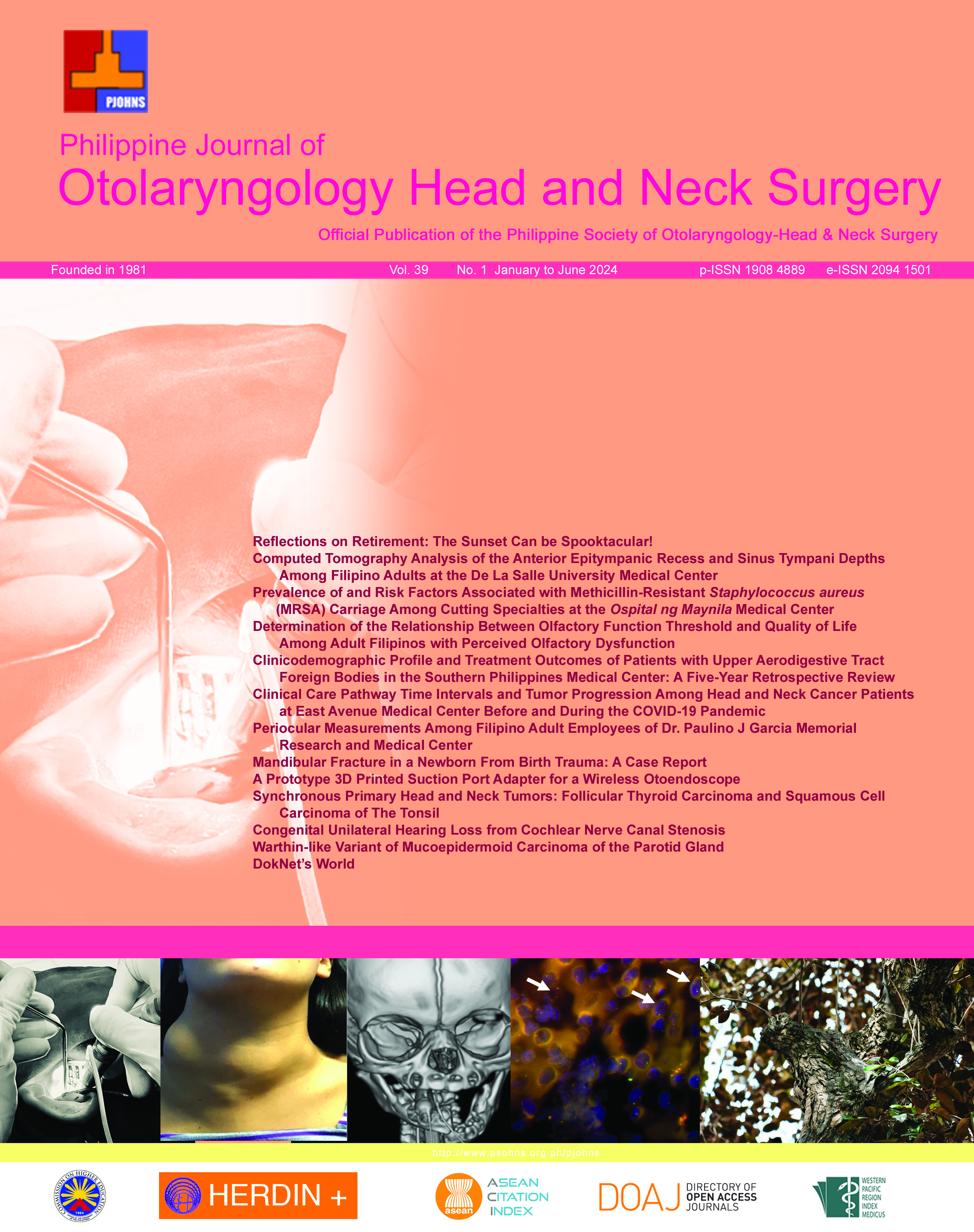Congenital Unilateral Hearing Loss from Cochlear Nerve Canal Stenosis
DOI:
https://doi.org/10.32412/pjohns.v39i1.2331Keywords:
cochlear nerve canal stenosis, congenital hearing loss, temporal bone imagingAbstract
A 2-month-old baby girl presented with a failed neonatal otoacoustic emission (OAE) hearing screening in the left ear. Combined Auditory Brainstem Response/Auditory Steady-State Response (ABR/ASSR) testing confirmed the presence of a unilateral left moderate to severe hearing loss. No Joint Committee on Infant Hearing (JCIH) risk factors for early childhood hearing loss1 were identified. She subsequently underwent computed tomography (CT) of the temporal bones to determine the presence of any inner ear malformation. No abnormalities of the internal auditory canal, cochlea, semicircular canals and ossicles were noted by the radiologist, and the study was officially reported as a “normal temporal bone CT scan.”
Independent review of the CT imaging revealed the presence of a visually apparent disparity in the width of the cochlear nerve canals. (Figure 1) Measurement of the cochlear nerve canal width in the axial plane parallel to the infraorbitomeatal line2 using the length measurement tool in the DICOM imaging software (RadiAnt DICOM Viewer, Version 2024.1, Medixant) indicated a cochlear nerve canal width of 2.18 mm on the right and 1.02 mm on the left. (Figure 2) Applying the suggested cutoff point of 1.2 mm as described by Lin et al.,2 we identified the presence of left cochlear nerve canal stenosis as the etiology of the congenital unilateral hearing loss.
The cochlear nerve canal, which has also been referred to as the bony canal for the cochlear nerve (BCNC), cochlear aperture, and cochlear fosette, is the bony transition point between the internal auditory canal and the cochlear modiolus. A relationship between a hypoplastic cochlear nerve canal and congenital sensorineural hearing loss was first suggested by Fatterpekar et al. in 2000.3 Subsequent studies confirmed the association between cochlear nerve canal stenosis and sensorineural hearing loss that ranges from near-normal to profound, with a statistically significant relationship between the degree of hearing loss and the degree of stenosis.4
Various cutoff points to define stenosis of the cochlear nerve canal have been identified in the medical literature. These cutoff points range from 1.2 mm to 1.7 mm when the canal width is measured in the axial plane.2 This particular case demonstrated clear-cut evidence of cochlear nerve canal stenosis, as it satisfied the smallest cutoff criteria (< 1.2 mm) seen in the medical literature.
The identification of cochlear nerve canal stenosis as the cause of congenital sensorineural hearing loss is important not only from a diagnostic point, but also from a prognostic perspective. Cochlear nerve deficiency has been noted to be highly prevalent among pediatric patients with cochlear nerve canal stenosis,5 and this has significant negative implications in relation to rehabilitation with external hearing devices and cochlear implants.
Downloads
Published
How to Cite
Issue
Section
License
Copyright (c) 2024 Publisher

This work is licensed under a Creative Commons Attribution-NonCommercial-NoDerivatives 4.0 International License.
Copyright transfer (all authors; where the work is not protected by a copyright act e.g. US federal employment at the time of manuscript preparation, and there is no copyright of which ownership can be transferred, a separate statement is hereby submitted by each concerned author). In consideration of the action taken by the Philippine Journal of Otolaryngology Head and Neck Surgery in reviewing and editing this manuscript, I hereby assign, transfer and convey all rights, title and interest in the work, including copyright ownership, to the Philippine Society of Otolaryngology Head and Neck Surgery, Inc. (PSOHNS) in the event that this work is published by the PSOHNS. In making this assignment of ownership, I understand that all accepted manuscripts become the permanent property of the PSOHNS and may not be published elsewhere without written permission from the PSOHNS unless shared under the terms of a Creative Commons Attribution-NonCommercial-NoDerivatives 4.0 International (CC BY-NC-ND 4.0) license.



